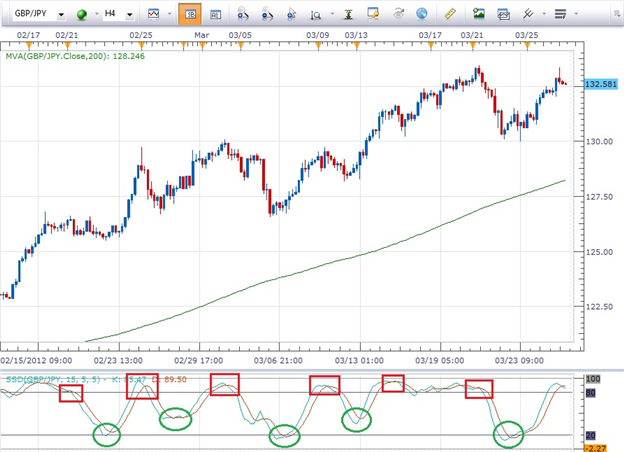Always remember that an indicator has absolutely no concept of trend. An indicator can provide invaluable information when it comes to momentum but it does not possess any insight as to the trend…the direction that the pair has been moving over time.
That being said, our first step when deciding the direction that we want to trade a pair for a greater likelihood of success is to determine the direction of that longer term trend. The direction that the market has been taking the pair is, hands down, our primary indicator.
Price action is Indicator #1.
Let’s take a look at the current 4 hour chart of the GBPJPY below…

We can clearly see that this pair is in an uptrend based on the bullish price action shown on this chart. The pair has been making higher highs and higher lows, it is trading well above the 200 Simple Moving Average (the green line), and at the time of this writing the GBP was the strongest currency and the JPY was the weakest.
Based on all of the above, we know that we only want to find reasons to BUY this pair as that will be the higher probability trade.
Knowing this and using the Slow Stochastics indicator that we have on the chart, we will only take buying signals and we will ignore any signals to sell the pair. Each of the buying signals is in the green circles and we can see that a buy position could have been taken successfully at each of those points.
The sell signals in the red boxes are to be ignored in an uptrend as they are higher risk trades since they are going against the dominant trend.
Keep in mind that a trader can still have a losing trade even when taking a higher probability entry. However, your likelihood of having a successful trade will be enhanced (not guaranteed) by entering trades in the direction of the trend when momentum, as signaled in this case by Slow Stochastics, shifts back in that direction.
In this instance we would be buying the pair after it “dipped” and retraced against the trend.
Bottom Line: Do not become a slave to the indicator. The indicator has no concept of trend, it only reflects momentum. As traders, it is up to us to determine the trend and then use our indicator of choice to only take trades in that direction.




